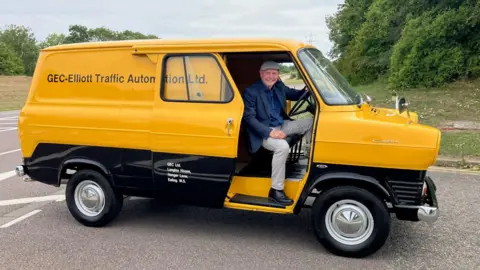**Beloved by Bands and Bandits: Celebrating 60 Years of the Ford Transit**
On the cusp of its 60th anniversary, the Ford Transit remains a familiar figure on the roads, cherished not only by tradespeople and commercial users but also by rock bands and notorious robbers alike. This iconic van, originally launched on August 9, 1965, at Ford’s assembly factory in Langley, Berkshire, has rewritten the rules of commercial vehicles with its unique blend of spaciousness, power, and versatility. Its design has undergone numerous iterations over the decades; however, its fundamental appeal has remained constant.
**A Time Capsule on Wheels**
Climbing into a 1965 Ford Transit can feel like stepping into a nostalgic time machine. With no high-tech gadgets like touchscreens or satellite navigation to be found, the original Transit spares only the essentials: a straightforward steering wheel, a chrome-lined speedometer, and chunky heater controls. The absence of seat belts, ineffective brakes, and the alarming tendency of the seat to shift around confirm that this is a vehicle from a bygone era. Despite its beautiful vintage appeal, it’s hard to grasp how this vehicle was once considered cutting-edge.
**Revolutionizing the Market**
When the Transit debuted, it was a game changer—offering significant space, a comfortable ride, and agile handling that outclassed its contemporaries like the Morris J4. Fast forward six decades, and the Ford Transit has grown to become the best-selling van globally, with over 13 million units produced. Edmund King, the president of the AA, reflects on its status as possibly the only iconic van people universally recognize amid a sea of celebrated cars. With a rich legacy, the Transit continues to be a cornerstone for many small businesses in today’s competitive marketplace.
**A Vehicle for Rock Stars and Builders**
Originally envisioned through collaboration between Ford’s engineering teams in the UK and Germany, the Transit quickly captured the hearts of builders, electricians, and delivery drivers. However, its appeal extended well beyond the trades, as it also became a beloved choice for budding rock bands. Icons such as Black Sabbath and Led Zeppelin roamed the roads in these vans, creating their own storylines on the way to stardom. As Peter Lee of the Transit Van Club highlights, the van symbolized freedom, enabling bands to travel and perform without constraints.
**The “Most Wanted” Vehicle**
The Ford Transit earned an additional layer of notoriety as it became the vehicle of choice for criminals in the UK. A Metropolitan Police representative once remarked that Transits were involved in 95% of bank heists, casting it in the role of “Britain’s most wanted van.” Its practicality, speed, and loading capacity made it ideal for quick getaways, further cementing its infamy in British culture. The stereotypical “white van man” appeared to embody this notion, suggested by the Sunday Times back in 1997 as an often troublesome character that drove a Transit.
**International Production Shifts**
For almost 50 years, the Ford Transit was produced on British soil. However, in 2013, Ford made the controversial decision to shift production to Turkey, citing cost-effectiveness as the reason. This move resulted in the closure of British factories and, unfortunately, the loss of hundreds of jobs, which unions described as a betrayal of the country. Yet, Ford remains committed to its British roots, with significant engineering and design operations based in Dunton, Essex.
**A Future of Electric and Intelligent Vans**
As the Ford Transit marks six decades since its inception, the company is focused on evolving the vehicle for future generations. While the core requirements of customers may still revolve around reliability and affordability, advancements in electric vehicles and integrated software solutions promise to revolutionize the industry once again. Seamus McDermott, Ford’s director of commercial vehicle development, points to how the future will hinge on propulsion and intelligent software—ultimately lowering costs and improving efficiency.
Despite its solid history of performance, the Transit faces an uncertain future. As King observes, the loyalty once possessed by loyal motorists may weaken in the face of increasing competition in the van sector. The Ford Transit, symbolic of hard work and freedom, is now evolving to meet the rapidly changing demands of the modern market. Nonetheless, it continues to hold a cherished place in the hearts of many, remaining an enduring emblem of the commercial vehicle landscape.











